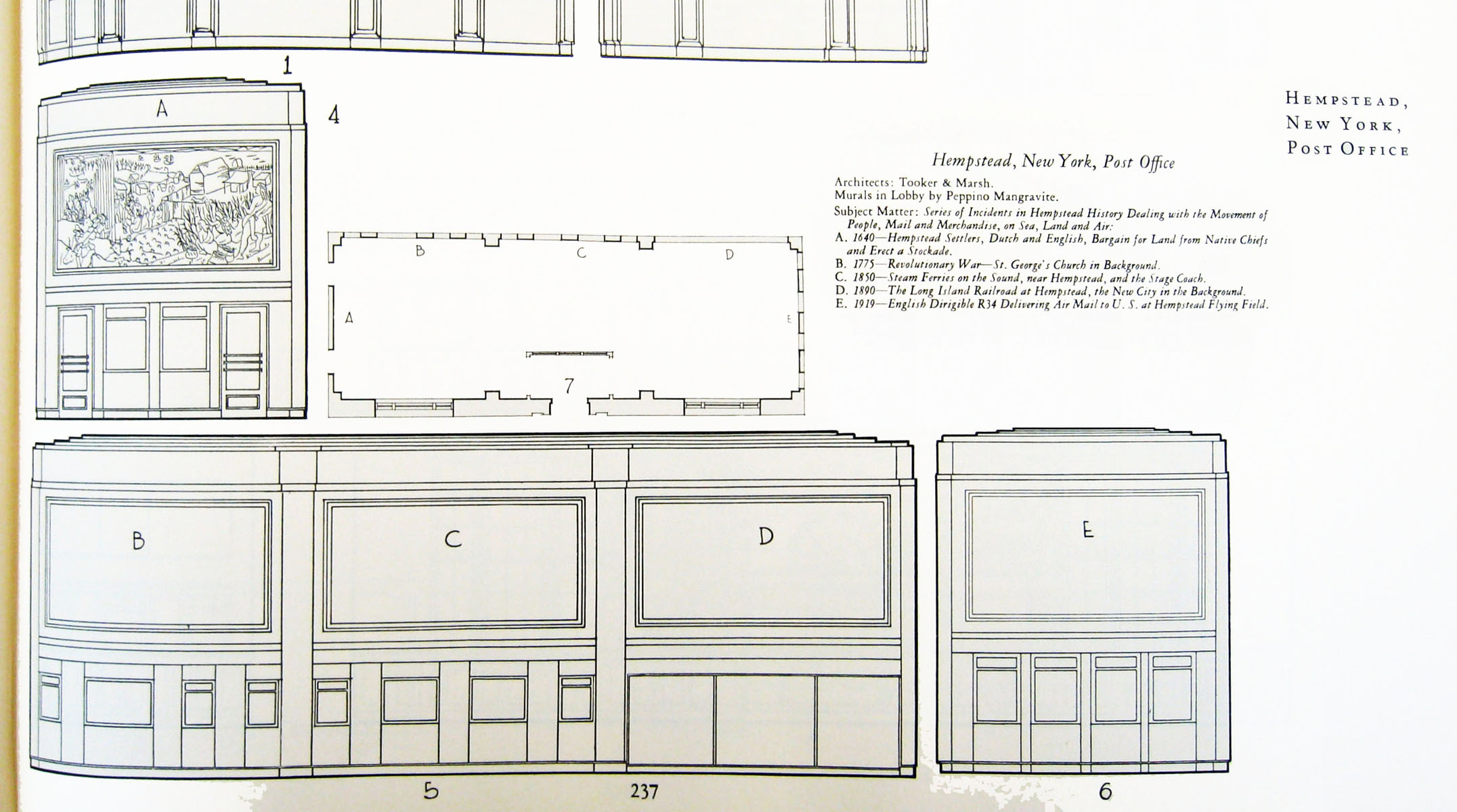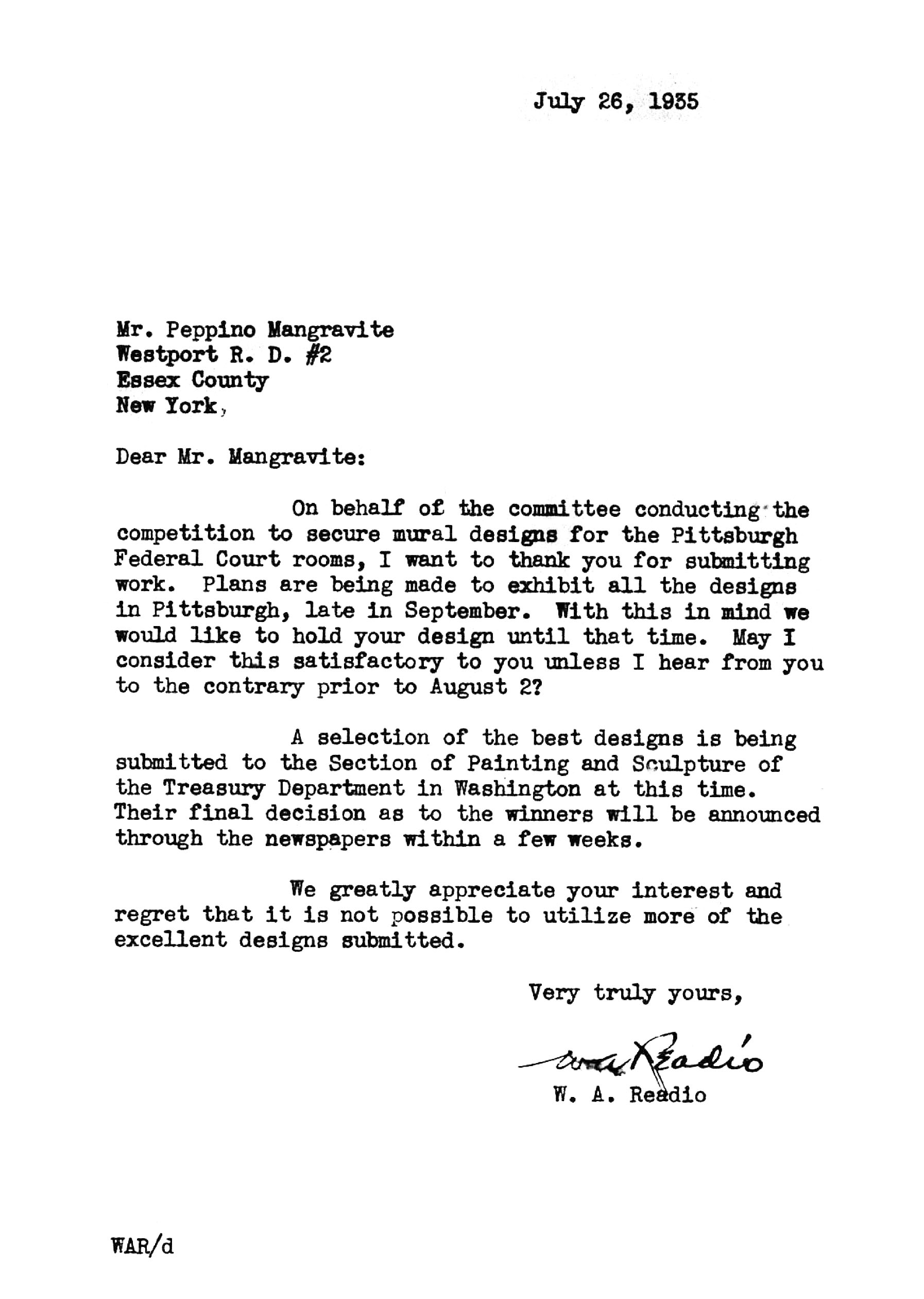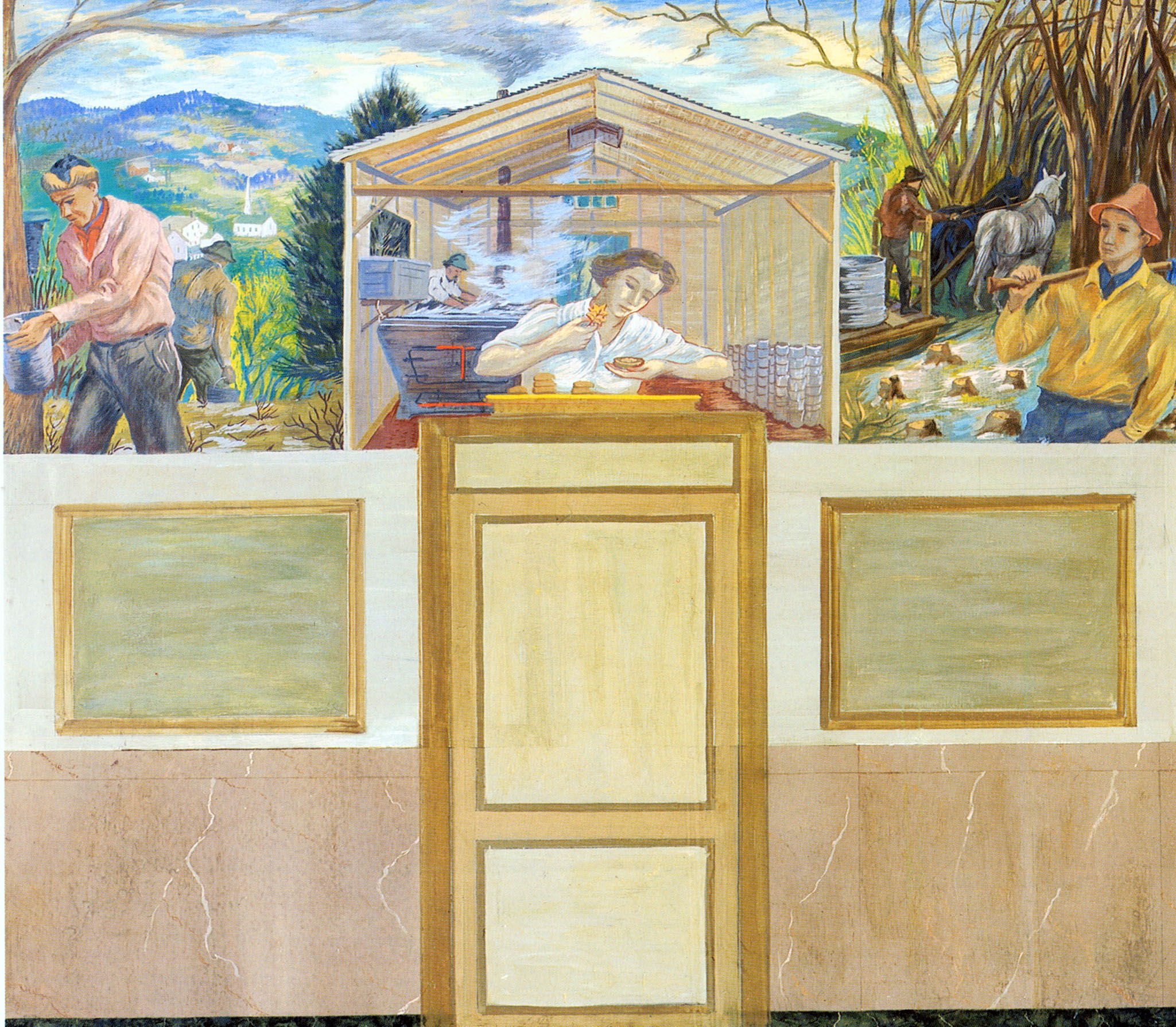


Drawing of the Hempstead Post Office mural plan from Art in Federal Buildings Volume 1, compiled by Edward Bruce published in 1936. The sketch shows Hempstead's hopes to have four murals painted by Mangravite.

Letter to Mangravite from W. A. Readio asking to display his sketches for the Pittsburgh Federal Court rooms murals in an exhibit. Peppino Mangravite Papers, 1918-1982. Archives of American Art, Smithsonian Institution., Real #5878, Image #396, Accessed September 2012, Copyright (c) 2013 Archives of American Art

Maple Sugar Industry, Vermont 1939, 33 1/2 x 42 in., Framed: 40 x 44 3/8 in., Oil on board, Created for the 48 State Mural Competition as the design for the Island Pond, Vermont Post Office. The proposed medium was oil wax on canvas.
In an effort to provide economic relief during the Great Depression President Franklin D. Roosevelt enacted many public works programs many of which are today known collectively as WPA or Works Progress Administration programs. WPA programs employing many out of work citizens and provided included projects such as construction of public buildings and roads and the creation of artistic projects meant to inspire. The first program to provide relief to artists was the Public Works of Art Project was (PWAP) started in 1933 and discontinued in 1934. At this time the Treasury Department Section of Painting and Sculpture / Section of Fine Arts (Section) program was created along with the Federal Art Project (FAP). These programs employed artists who created of posters, sculptures, murals, paintings and plays, along with providing art instruction for the public.
Looking to the work of the Mexican muralists Diego Rivera, Jose Clemente Orozco, and David Alfaro Siqueriros whose murals were used not only as aesthetic enhancements to public buildings but as ways to express the social values of the country. The Section program, administered by the Procurement Division of the United States Department of the Treasury, required that the artists compete for the mural commissions. The selected murals were installed in schools, post office buildings and other public government buildings. The installation of these murals became a moment of pride for many towns as the values and history of their communities were put on display.
With the United States entrance into WWII the programs were discontinued and as popular artistic styles changed many of the works were destroyed or lost, however some of the murals are still on view to the public throughout the country. Unfortunately their future is uncertain as government building are sold or replaced with new buildings, and the history of many of the works has been forgotten.
In early 1934 Mangravite contacted the PWAP looking to participate in the program. However with the closing of the program, and the uncertainly of a new program starting, in June Forbes Watson wrote in reply that while “you could do a swell mural… we haven’t any very tangible plans for giving out definite mural projects.”1 As the programs under the control of the Treasury Department formalized in the following years Mangravite submitted sketches for the Section mural competitions. In July of 1935 he submitted a design for the Pittsburgh Federal Court room competition. While Mangravite’s design was not selected as the winner his entry placed his name in Forbes Watson's "Recommended for appointment as a result of Justice Competition” folder.2
By the time the Section program ended in the early 1940s Mangravite had completed four mural commissions, two in New York, one in New Jersey and a set for the Governors’ Mansion in the Charlotte Amalie, Virgin Islands. One in Hempstead, New York was hung in 1937 and the Atlantic City set was hung in 1939. The last two mural commissions would be hung in 1940 and 1942, just as the program was ending. During this time he took great care in the selection of the murals content, declining a 1937 commission for the Southwark Post Office due to subject matter.3
Mangravite received $4,425 for the Hempstead, New York commission and three years later he was paid $1,500 for his Jackson Heights, New York mural.4 He was happy to have the additional income however he participated in the program because he wanted an opportunity to paint murals for the public. He believed in the progressive era educational model of teaching through seeing and the importance of murals in the education and growth of the country. As a foreign born artist, it was important for him to take part in the murals movement because he believed that “young Americans had lost the American Dream to push them forward.”5
Peppino Mangravite Papers, 1918-1982 (Archives of American Art, Smithsonian Institution. n.d.).Reel #5878 Image #274. There was no record of the letter which Mangravite had sent to PWAP, only the response.↑
File folder of Forbes Watson. This document is in the collection of the National Achieves at College Park (NACP), College Park, MD, in Record Group 121 (Records of Federal Works Agency. Public Buildings Administration. Section of Fine Arts. (1939 - 1949) (Most Recent)Department of the Treasury. Procurement Division. Public Buildings Branch. (06/10/1933 - 07/01/1939) (Predecessor), Correspondence of Officials, Compiled 1934 - 1943), Inventory Entry 125 (Forbes Watson Correspondences 1935 -1941), Box 2. Hereafter, materials in the record group 121 will be cited by a descriptive phrase followed by the inventory entry number and description, and a box number.↑
Peppino Mangravite Papers, 1918-1982. Reel #5878. In an April 6, 1937 letter from Edward Rowan to Mangravite, Rowan “explained to the architect that it was the subject matter which did not appeal” to Mangravite. It continues on to express that Mangravite felt that the building should in fact not have any mural decorations.↑
The Hempstead, New York mural was actually funded by Treasury Relief Art Project (TRAP) though the commission was granted and overseen by Section. Francis V. O’Connor, “The New Deal Art Projects in New York,” American Art Journal 1, no. 2 (October 1, 1969): 70.↑
Helen Appleton Read, “Peppino Mangravite,” Parnassus 6, no. 2 (February 1, 1934): 14.↑